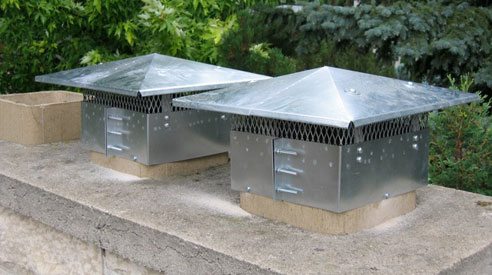Chimney Caps

Imagine how much water would come into your home during a rainstorm if you had a hole in your roof twelve inches square. Chimney flues may be even larger than that, so where does all that water go? It runs down the chimney and seeps into the bricks and mortar, settling behind the firebricks. There is little air circulation in the chimney (unless you’re using it) and no sunlight, so the inside of the chimney stays wet long after the rain stops. This moisture erodes the mortar joints and weakens the brick. Add to this a freeze/thaw cycle during the cold months, and you have all the needed ingredients for a deteriorating chimney.
Take our word for it:
even though you can’t see the damage happening, it’s there, slowly deteriorating your beautiful fireplace and chimney. This is a particularly important consideration if you have a metal firebox incorporating a metal damper and smoke shelf. All fireplace dampers made of metal are subject to this deterioration as the water mixes with creosote and mild acids are formed. Even chimneys serving wood stoves are in need of a cover.
Listed below are several good reasons to have a chimney cap:
- Keep out rain, snow and sleet.
- Keep out animals and birds.
- Keep out leaves, twigs and other debris which could lead to a blockage or chimney fire.
- Keep sparks from leaving the chimney and igniting nearby combustibles.
- Help eliminate wind induced downdrafts.
Chimney caps are made from a variety of materials. The most common are galvanized, aluminum and stainless steel. Caps made of stainless steel will last much longer than those made of regular galvanized metal and normally carry an extended warranty. Spending a little extra for a good quality chimney cap will be money well spent and there will be no danger of rust staining the chimney.




